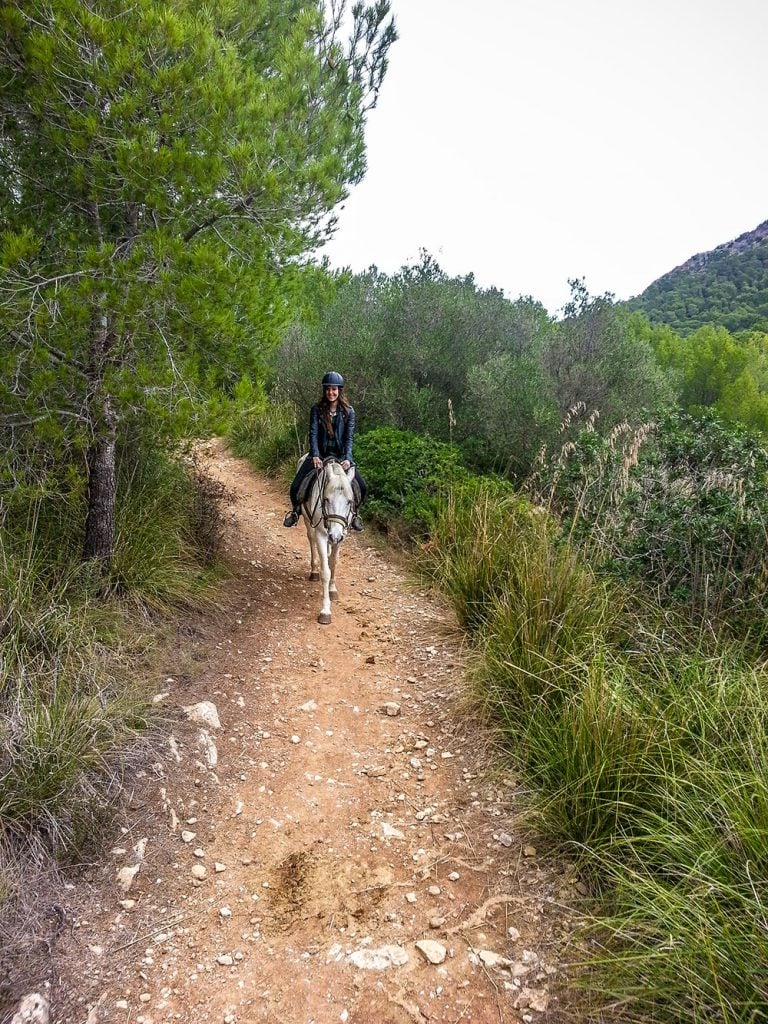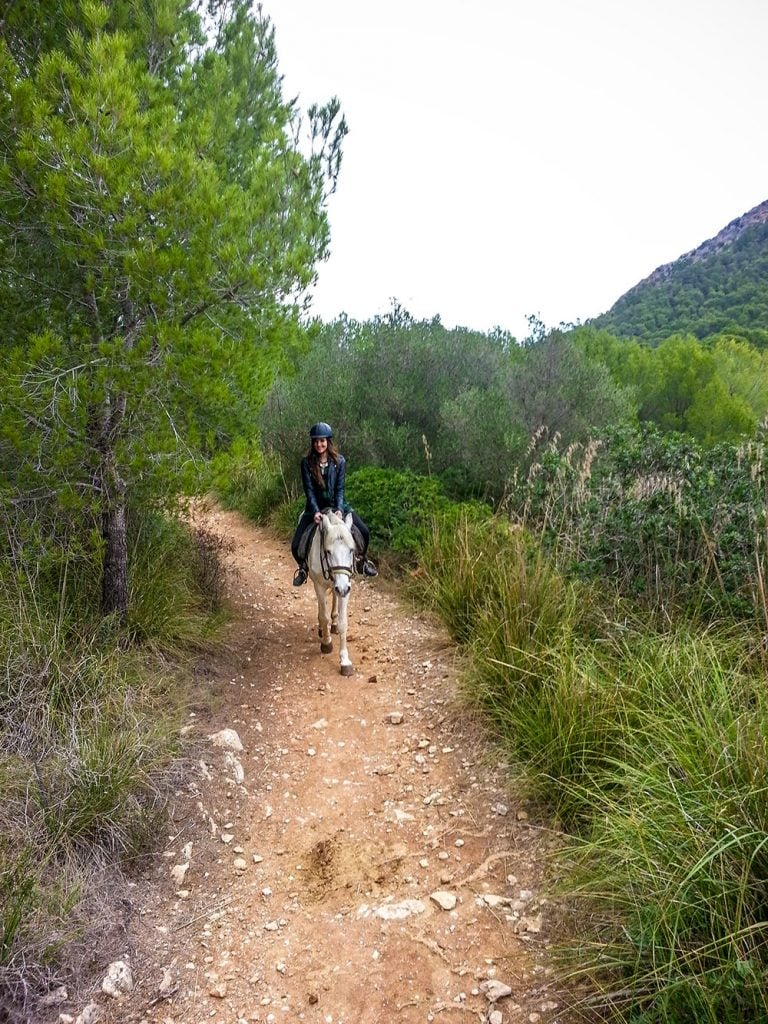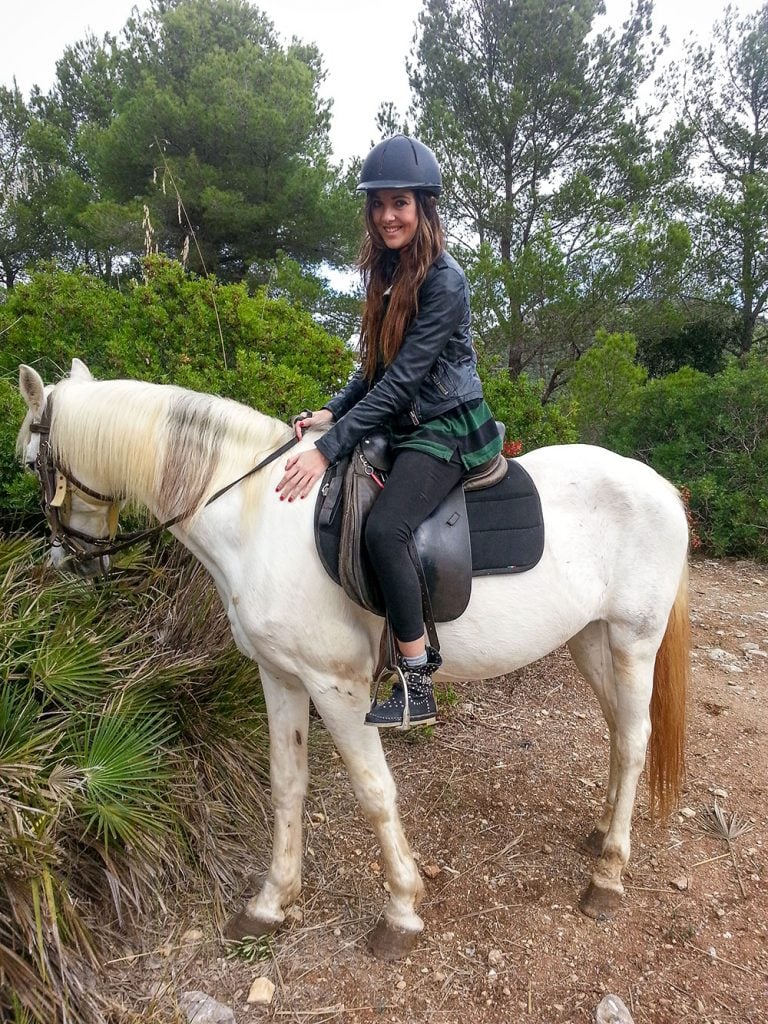
Mallorca is an island of diverse and beautiful landscapes. From golden sand beaches fronted by crystal clear waters to the mountainous interior where dense, evergreen forests coat craggy peaks, Mallorca really is a haven for nature lovers and those who love outdoor activities. With roads that wrap round the sides of mountains, dotted with sharp hairpin bends, the island is ideal for cyclists. But what about horse riding?
I’d been to Mallorca countless times but, despite being an avid horse rider, I had never ridden on the island. My times were instead spent ambling round small villages tucked away in the mountains or unwinding on beaches (although, not every beach experience in Mallorca has been pleasant. I got a drug syringe wedged in my foot by running along one beach!).
But on this trip, I was keen to get in the saddle. After all, I’d had some fantastic horse riding excursions whilst in other countries: trotting on beaches in Barbados and exploring the cold Scottish highlands on a sturdy pony with the longest mane I had ever seen.
Where to Horse Ride in Mallorca?
There are in fact numerous stables in Mallorca which offer horse riding treks. When choosing a stable to visit, it’s important to research the stables and check reviews. As with any activity which involves animals, it’s imperative to know if the animals are in good condition and are treated well. I wrote an in-depth post about the dark side of wildlife tourism but the same caution should be applied when contemplating tourism involving domesticated animals.
I booked a 2 hour trek at a stables called Ranxo Ses Roques, based just outside the coastal town of Alcúdia in the north of Mallorca. The stables are open year-round which was ideal as I was visiting in the low season (November). Reviews for the stables were good and when looking at photos of the horses, they all looked healthy.
Horse Riding Treks with Ranxo Ses Roques: The Details
The stables offers treks of various lengths. The shortest trek length is 1 hour and costs €24 per person. A 2 hour excursion costs €45 per person. You can also have a customised private trek. Helmets are provided by the stables and your trek will be led by a guide on horseback.
The trek takes you through peaceful forests, ascending a mountain, known as Puig De Sant Martí. At the top of the mountain you are greeted with gorgeous views of Alcúdia.
If you are visiting between November and March then you have the opportunity to ride on a beach (this is a 2 hour excursion) for €60 or go on a cultural ride through nearby villages for €75. These tours are only available in low season.


My Experience Horse Riding in Alcúdia
I was based in the south of the island. As a result, it was an hour’s drive to the stables. The stables is situated not far away from the main road to Alcúdia but that didn’t stop me from getting lost a handful of times and nearly ripping my hair out as I studied Google Maps, pondering where I went wrong.
Eventually we found the stables. As it was low season , myself and my companion, Lewis were the only ones taking part in the 2 hour trek.
Being tall, Lewis was given the largest horse, a long-legged bay gelding. I was given a shorter horse which was snow-white with a long mane. My horse lacked the enthusiasm which Lewis’ horse seemed to possess.
We mounted our rides and followed our guide into the wilderness.
I listened to the sound of hooves on the hard, stony trail and felt the chill that wrapped itself around me. Late November meant that the temperature had a bite to it. I turned my eyes to the sky, noticing how the sun was completely concealed by a blanket of dark clouds.
It didn’t take me long to realise my horse wasn’t the fastest of the bunch. It kept stopping every few minutes to have a nibble of the vegetation. I nudged it forwards, sensing the horse’s reluctance and having to battle with it every few minutes. My legs became tired of their persistent nudging as I fought not to get left behind Lewis and our guide.
Beautiful mountains rose up on our right, coated in dense forests. I listened to the buzzing of insects radiating from nearby Aleppo pine trees. On our left was a tall wall, separating us and the wilderness from a row of neat houses.
Up ahead I noticed a low bridge which took us underneath a road. We stopped just in front of it and I felt nerves rising up within when I took in just how low this bridge was. We’d have to duck down to get under as it was, but what concerned me the most was what was waiting for us on the other side. The concrete ground steeply rose up on the other side at almost a 45 degree angle.
The path we had been walking on so far had been soil and gravel and so I eyed the concrete slab up nervously, knowing that it wasn’t the most grippy terrain for a horse’s hooves. The steep raise in the ground would mean that we’d have to duck as low as we possibly could to avoid hitting our heads on the bridge. I could almost hear Lewis swallowing nervously – Lewis who was far taller than I was and who was on the tallest horse of the group.


The guide went first, closely followed by Lewis. I watched as both horses slipped as they walked across the concrete, frantically moving their legs to try and get a grip on the slick surface.
The scraping of hooves sounded loudly in my ears and I gasped in horror as Lewis’ horse practically fell to its knees, legs trembling frantically as it tried its hardest to keep itself on its feet whilst attempting to ascend the concrete slope. The bay horse finally got its grip and continued on the trail.
I breathed out a sigh of relief before realising it was my turn to tackle the bridge.
I leaned as far forward as I could as my horse climbed the hill. It skidded a little but overall our ascent was a lot more graceful than the others.
After conquering the bridge, we ventured up into the mountains along a narrow dirt path. It was a relaxing ride through the trees. Birdsong filled my ears and trees swayed gently in the cool breeze.
Before long, we reached the top of the mountain, known as Puig De Sant Martí which stood at 266 metres in height. Here we stopped for a break. We got to dismount and have a little walk around the clearing. From the top of our mountain, we had a wonderful view of Port d’Alcúdia with the sea glistening in the distance.
On our way back, we decide to have a little trot through the woodland. I grinned with excitement as I gave my white horse the signal to trot. I began to rise and fall with my horse’s movement, having to keep applying pressure with my legs in order for my horse to keep up with the guide.
Just then I saw a rush of brown out of the corner of my eye. I giggled as Lewis’ horse charged forwards in a rushed trot, overtaking the guide with ease. Lewis sat back, smiling, seeming to have no control over his steed’s gait.
The guide increased his pace and with a look of sheer determination on his face, he grabbed the reins of Lewis’ horse and encouraged him to walk.
Lewis had probably ridden a horse only once in his life before this and still had a lot to learn.
The journey back retraced our steps through the dense forest and I knew at some point that the low bridge and steep descent into it would arise.
It looked even more challenging coming down the slope than it did coming up. The horses would likely skid down the slope at a fast speed and we therefore had to duck backwards to avoid smacking our heads on the low bridge and being violently forced off our horses.
Our guide went first. I watched as he leant as far back as he could and then gasped when his horse lost his footing and went skidding down into the tunnel.
Lewis went next which was particularly nerve-wracking due to his height. His horse began to skid and Lewis made an effort to lean as far back as he could. He narrowly avoided a terrible collision with the bridge and I let out a sigh of relief.
It was my then turn which wasn’t as scary. I felt experienced in the saddle and my horse was far shorter than Lewis’.
Sure enough, my descent was smooth and we could all return to the stables alive!
